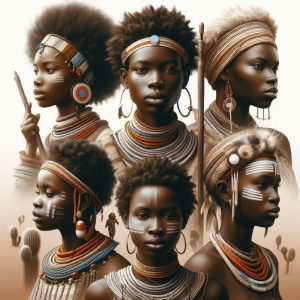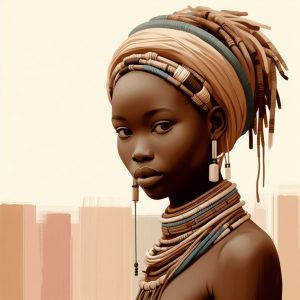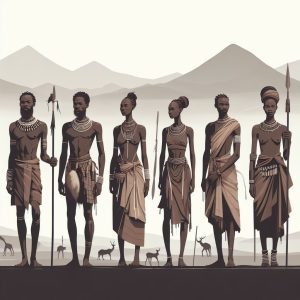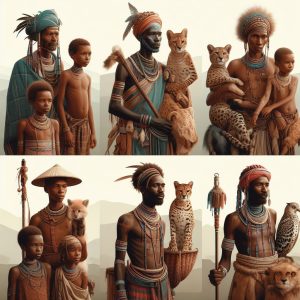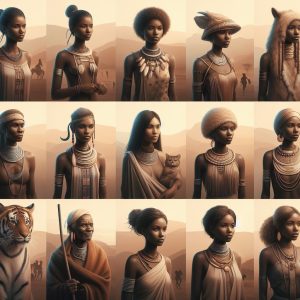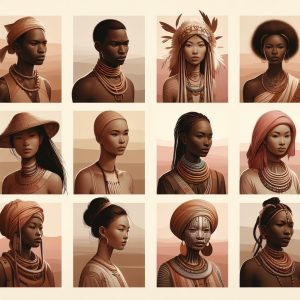Captivating Traditions of African Tribes
With over 3,000 distinct ethnic groups, African Tribes’ culture remains as diverse as the vast continent. From the cattle herders of the Maasai to the desert nomads of the Tuareg, vibrant tribal communities are the lifeblood of society across Africa. These groups retain age-old customs that anchor them to their ancestry and provide unity in daily life.
The Legendary Warriors of the Maasai
The semi-nomadic Maasai dominate the savanna grasslands of Kenya and Tanzania as highly skilled cattle herders. While pressing issues like land rights and environmental preservation threaten their traditional way of life, the Maasai culture lives on through its people’s resilience.
Clothing and Ornamentation
| Style Item | Description |
| Shuka Blankets | Rectangular red cloth wrapped around the body |
| Beaded Jewelry | Intricate and heavy necklaces, bracelets, and earrings in vibrant colors |
| Warrior Locks | Long braided or loosely hanging hairstyles dressed with ochre pigment and animal fat |
| Leather Sandals | Handmade leather footwear with flat soles |
These styles identify Maasai’s stages of life. Bold colors and elaborate accessories denote prestige.
Vibrant Attire and Ornamentation
Clothing and personal decoration for the Maasai denote not only aesthetic taste but critical information on an individual’s place in society. Most recognizable is the cotton shuka, a large rectangular red cloth draped around the body by warriors and elders. Intricate beadwork in electric hues adorns necklaces, bracelets, and ear piercings in wide, dramatic styles. Complex braided hairstyles dressed with earth pigments and animal fats complete the look.
In Maasai culture, such artistic fashion and piercing designs signify progression through life stages more than age alone. Jewelry craftsmanship also broadcasts social standing, wealth, and prestige through bright colors and dense ornamentation.
Cattle at the Center of Cultural Life
For the Maasai people, cattle represent far more than just a protein food source. The herd signifies the pumping heart of Maasai society itself. Cattle serve as financial currency, social status, marriage dowry, political power, and ceremonial focal points. Elders arrange children’s marriages based on an exchange of cattle, brokering deals that transfer daughter-brides between patrilineal family groups across the region. A young man cannot take a wife and build a homestead until he acquires enough livestock through raiding or inheritance. And when a herder dies, cattle pass directly to his eldest son.
Beyond exchange value and livelihood, cattle anchor the Maasai worldview. Gods enjoin raising cattle in origin stories and oral legends. Protecting the herd constitutes protecting the sacred web of Maasai culture itself.
Transitioning to Tourism
Over recent decades, pressures on usable grazing lands have threatened the viability of nomadic pastoralism for the Maasai people. At the same time, outside influences have put their coming-of-age rituals, female genital mutilation practices, and other customs under scrutiny. Many younger generation Maasai now settle in designated villages rather than roaming the plains. Groups of elders have organized to eliminate controversial traditions like female circumcision while advocating for indigenous land rights.
To navigate this shifting landscape, some Maasai have integrated modern economic practices with their strong heritage through cultural tourism enterprises. Villages welcome visitors to watch warriors demonstrate hunting techniques up close or craft beadwork as artisans have for centuries. Tourism helps local economies stay afloat while providing a platform for sharing and sustaining Maasai culture far into the future.
The Storied Arts of the Dogon Tribe
On the dramatic golden Bandiagara Escarpment carved by the Niger River, villages along the central Malian cliffs have retained continuous culture for over five centuries. Oral histories date Dogon’s settlement here to the late 1300s as small groups sought defensive refuge. Stacked earthen cube homes integrated with the sandstone provide shelter and temperature control. Carved wooden masks and statues represent ancestral spirits, guiding the community through ceremonies to ensure prosperity.
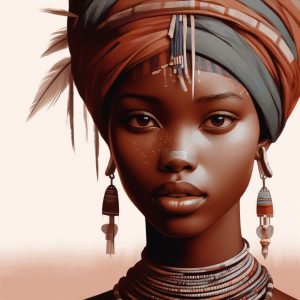
Particularly striking are the intricate Dogon mask dances performed by guiding elders. Ritual performers wear dramatic facial coverings, interpreted as spirits manifesting on earth to maintain cosmic order and impart wisdom.
Communal Cliffside Living
Sheltering into the Bandiagara provided natural defensive fortification from warring groups for early Dogon settlements. The cliffs also offered shelter from the blistering sun and extreme temperature shifts of central Mali’s arid climate. Stacked earthen cubicles line along the escarpments, housing generations of Dogon families in cramped harmony. When a wife joins her husband’s kin group, she moves to these cliff homes where she will raise children, gather water from the base, cook meals, and engage in daily living.
Elders gather at meeting points to exchange news, arbitrate disputes, arrange marriages, and make decisions for Dogon society. Grandmothers care for young children while older kids run and play games across neighboring terraces. The oral tradition runs deep here, with tribal lore and customs imparted to each new generation atop the very cliffs their ancestors carved out survival over six centuries ago.
Carved Masks and Guiding Mythology
Common across Dogon visual arts are hieroglyphic shapes, bold colors, and geometric abstraction. Masks invoke ancestors and guide spirits through symbols carved into native African hardwoods by skilled artisans. Masked dances honor past cultural heroes, strengthen community bonds, and restore perceived imbalances by reenacting origin myths.
Symbols of Mythology
| Mask Name | Meaning |
| Antelope Masks | Fertility and successful hunts |
| Kananga Masks | Wisdom, speech, and guidance |
| Sirige Masks | Feminine beauty and nurturing |
Carved from native hardwoods, Dogon ritual masks represent ancestors, Nommo spirits, and cultural ideals during sacred ceremonies
Antelope masks symbolize fertility and successful hunts. Kanaga masks, named for seeds, represent speech, language, and moral guidance to society. Sirige carvings with long horns and spheres depict femininity, beauty, and the lifegiving universal Mother. All mask dances reaffirm the core tenets of faith and duty that organize Dogon society.
The Awa Protectors of Culture
A secretive guild of tribal sages known as the Awa safeguards Dogon masks, ritual altars, oral histories, and sacred customs from outside influence. Members inherit lifelong duty through bloodline special ability to commune with ancestral spirits. The elderly men are keepers of cultural purity, guiding the proper practice of ceremonies like the epic Sigui festival to restore cosmic order.
The Sigui draws thousands of observers and dancers who converge in elaborate garb once every 60 years. As Mali modernizes amid globalizing pressures, the Awa’s anchoring influence helps buffer Dogon culture from extinction. This spiritual leadership ensures new generations appreciate their heritage and four millennia of continuous cliffside living.
The Himba Herders of Namibia’s Deserts
In the stark Kaokoland desert landscape along Namibia’s northwest Kunene region, the Himba persist as nomadic cattle and goat herders quite independent from a centralized society. With ancestral ties to the greater Herero peoples, they migrated here around 1600 AD but retreated from German colonizers into the remote desert mountains in the early 1900s. Without roads or basic state services, the Himba designed a sustainable life reliant on livestock and the harsh yet striking backdrop they call home.
Thanks to determined autonomy and relative isolation, the Himba have cultivated robust indigenous customs and villages little touched by outside influences. But recent years have tested their cultural resilience, as encroaching modernization conflicts with their strong rural heritage rooted in the Namib sands.
Skin Protection and Stylized Appearance
The visual presentation of the Himba people inspires astonished outsider photographers but holds deep cultural meaning. A signature feature is women’s clay-infused hair, dreadlocked then coated in thick red ochre pigment into elaborate styles denoting marital status and age. Theotuko headdresses made of leather, shells, fur, and hand-carved ornaments finish the captivating look.
Women also spread a paste of butterfat, ground ochre, and aromatic resin over their entire bodies, shielding them against the desert sun. Wearing only simple leather aprons and jewelry further allows free movement through the rocky climate herding livestock.
Gender Roles and Settlement Patterns
Himba society is male-dominated in political decisions but women hold responsibility for daily homestead operations. Men often take multiple wives for status, inheritance of property, and higher bride prices paid through cattle exchange. The household or Uganda makes up a patrilineal extended family, clustering circular mud and thatch huts around a kraal livestock enclosure and led by the eldest male. Chiefs coordinate broader regional assemblies focused on clan relationships, water access rights, border disputes, and patriarchal governance issues.
Semi-permanent family compounds cycle across the land based on seasons, water availability, and livestock grazing patterns. But Himba’s identity stays rooted within the person more than a place. Their understated aesthetic suits the environment while bonding members to tribal ancestry and oral traditions passed through generations of life tuned to nature’s rhythms.
Safeguarding Ways Against Modern Influx
From the 1970s, the South African administration brought more roads connecting Himba lands to larger Namibian cities. Some tribespeople now integrate modern infrastructure and capitalism to operate market stalls serving visitors. But overall, external forces poor in for mixed blessings.
Christian missionaries aggressively converted some villages; youth sent to high schools outside their culture often cannot integrate back. Illegal land purchases for mining threaten ancestral territories and water rights. Many Himba wish to balance modest modernization with preserving the autonomous structure sustaining their vibrant heritage for centuries. Tribal leaders now push the Namibian government for formal land protections and isolated schooling to pass proud Himba identity safely into an uncertain future.
Shared Threads Across Tribes
These vignettes provide but a glimpse into three of Africa’s countless vibrant tribes grappling with cultural continuity with winds of change. Maasai, Dogon, and Himba peoples have maintained independent, tight-knit societies thanks to ancestry-rooted customs that structure daily life. From coming-of-age rituals to masks stirring spirits; cattle currency to body aesthetic; oral lore binding generations to bloodline identity rooted in the land.
Yet wider sharing of once isolated lifeways brings both connectivity and dilution. Facing this modern tension, tribespeople increasingly fight for sovereign autonomy and rights of self-determination. Globalization will not wholly erase traditions over one thousand years. But active efforts to balance the best of both old and new help ensure the laughter and drum beats of Africa’s indigenous heartbeat march on.
References:
- Maasai People. (2023, January 7). In Wikipedia. https://en.wikipedia.org/wiki/Maasai_people
- Meyer, G. (2004). Tanzania Tribe Marks Rite of Passage. Los Angeles Times. https://www.latimes.com/archives/la-xpm-2004-aug-15-adfg-maasai15-story.html
- Errington, F. & Gewertz, D. (1989). Tourism and Anthropology in a Post-Modern World. Oceania, 60(1), 37-54. https://www.jstor.org/stable/40331363

